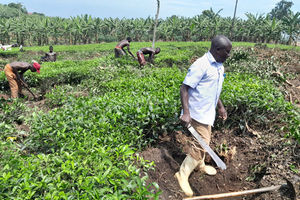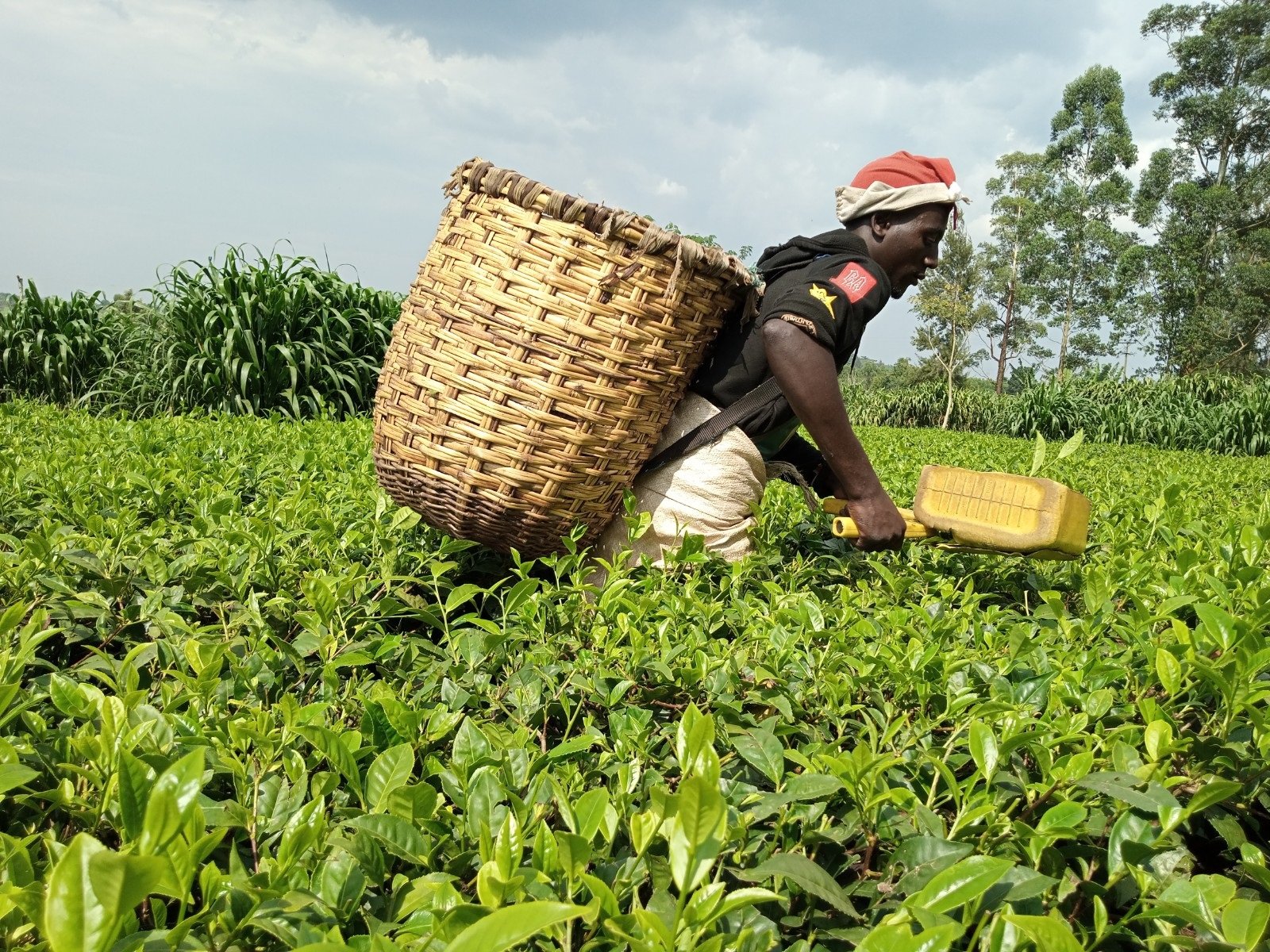
Tea value chain consultant and Uganda Tea Out growers Association leader Onesmus Matsiko. PHOTO/ILLUSTRATION
It is the beverage of choice for many Ugandans. In fact, if our interview was conducted during the morning, the odds that a pot of tea would have been ordered are quite high. Yet to come to the conclusion that there is more than a storm in Uganda’s teacup is anything but a stretch. Uganda’s tea sector has run into a perfect storm and help from the government is not assured after the deputy secretary to the treasury, Patrick Ocailap, recently revealed that no figure for a bailout was shoehorned into the budget for the financial year (FY) 2024/25.
When I talk to Onesimus Matsiko, a tea value chain consultant who also serves as the Uganda Tea Outgrowers Association chief, optimism is in scant supply.
“The tea industry has not recovered,” he tells me matter-of-factly.
Balding, he trims his hair short. While this makes him look neat, the manner in which prices of Uganda’s teas have been trimmed in recent times has left players in the tea value chain crying foul. It is not just persistently low prices that the players are grappling with. For instance, during the sale 31 at Mombasa, 53.5 percent of the teas remained unsold according to the tea market report by Tea Brokers East Africa Limited.
The prices of tea at Mombasa have also remained low, averaging $2.20 per kilo compared to Kolkata $3.59 per kilo and Colombo $4.10 per kilo.
A perfect storm
On the demand side, the Mombasa auction watchers say Pakistan that buys 90 percent of Africa’s tea is experiencing hot weather conditions, thus, reduced consumption of the beverage. And the Europe market is reported to be in the holiday mood while the region, Sudan, which used to absorb some the teas, is locked in a civil war.
Latest Bank of Uganda latest data shows monthly tea export earnings have dropped significantly by Shs5.6 billion ($I.5 million) in the 12 months ending May 2024, from Shs27.6 billion ($7.41) million to Shs22 billion ($7.41million) raked full year to May 20, 2024.
Besides the disruption in supply chain owing to shipping companies rerouting their ships around Africa and the Cape of Good Hope, a longer and expensive route to Russia is also taking a toll on the volumes sold.
Matsiko tells me that trading sessions at the Mombasa auction are characterised by compressed demand relative to supply of CTC black teas. Uganda exports mostly CTC black teas, which have continued struggling for remaining of low quality. This is in stark contrast to Orthodox tea, especially green tea, and a variety of specialty teas, which are performing more stably both in absorption and price earnings at the auctions.
By the way, CTC, Matsiko tells me, is an acronym for. Crush, Tear, and Curl or Cut, Tear, and Curl. During this method of processing black tea, the tea leaves are passed through a series of cylindrical rollers with serrated blades that CTC the tea into small, even-shaped pellets. Known to be bright and brisk, with a multilayered flavour profile, orthodox teas are traditionally made or processed by plucking, withering, rolling, oxidation and drying.
Anyway, as a result of the low demand, there is pressure on the realisable prices, a development that sends signals it’s no longer a mere factor of good quality teas grown. Matsiko uses the word “crisis” to describe what has set in due to low absorption capacity. The woes in the industry have hit smallholder farmers harder with a farm gate price of green leaf dropping from highs Shs500 ($0.13) to anywhere between Shs200 ($0.05) to Shs130. The farmers net earnings have also slid to Shs30 ($0.008) after paying pickers Shs100 ($ ($0.02) per kg, hardly enough to cover operational costs.
The liquidity crisis is forcing smallholder farmers to give out their gardens for free to the landless people to cut down and plant first growing crops for two seasons. It’s understood that the more pressed farmers are shading off properties, albeit at giveaway prices, to service loans and pay school fees, amid potential buyers asking for discounts, for uprooting the tea plantations.
This has sent an acre of a planted tea garden, which used to cost Shs13 million ($3,480), three years ago, down to Shs5.5 million ($1,472) compared to bare land which currently costs Shs6.5 million ($1,740), players tell Lunch with the DM.
Fertilisers
Pushed on the wall, the tea farmers have renewed a push for subsidies to shore up the cost of fertilisers that have nearly doubled from Shs120,000 to Shs200,000 in the aftermath of the Ukraine-Russia war.
In the region, Kenya introduced a 30 percent fertiliser subsidy for its tea—a measure that helped the country increase its annual tea production by 67 million kilogrammes.
Little wonder, researchers at Economic Policy Research Centre (EPRC) vouch for targeted fertiliser subsidy to unlock Uganda’s tea productivity that has stagnated at about 1,600kg per hectare, compared to the potential 4,000kg per hectare.

A worker plucks tea leaves from the garden in Kabarole District. PHOTO/ALEX ASHABA
The EPRC observes that Uganda has been exporting less than 70 million kilogrammes since 2020 due limited use of productivity enhancing inputs like fertilisers even when the cash crop is a nutrient-depleting.
But with fertilisers application tea prices are expected to increase by an estimated 33 percent from the current $0.79 per kilogramme year-to-date to $1.05 after the intervention and also improve the quality.
Mr Matisko tells me that farmers are also betting on the application of fertilisers to improve Uganda’s green tea quality.
The productivity is expected to increase by 50 and at the end of its yield and price increase could double Uganda’s foreign exchange earnings from the current estimated $25 million to $50 million for a season. Farmers estimate that the intervention will generate more than 100 percent extra earnings from the financial investment within six months.
Regulatory vacuum
The tea sector also faces another challenge of a regulatory vacuum. This, Matsiko notes, has fed misinformation to top government leadership. He further tells me that President Museveni and his Cabinet have been approached with a request for a “Tea Authority.”
“The most urgent, practical and affordable intervention that can be implemented in a short term is establishment of a tea green leaf standard,” suggests the expert, adding that this is the most effective and most affordable intervention for the tea industry. Against this background there are growing calls for Uganda to work on product quality and make it sell.
Under normal circumstances, Uganda offers around 15 percent of teas from East Africa to the world market.
This volume is small enough to be absorbed compared with, for example, the more than 70 percent offered by Kenya.
Tea is one of the priority cash crop commodities introduced in Uganda by the British in the early 1900. It attracted 80,000 farming households in tea production and it supports over 150,000 skilled and unskilled workers. Approximately, 1,000,000 people directly derive their livelihood from tea growing in the country.







